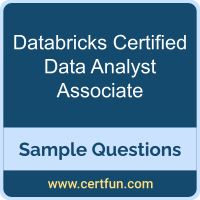 The purpose of this Sample Question Set is to provide you with information about the Databricks Certified Data Analyst Associate exam. These sample questions will make you very familiar with both the type and the difficulty level of the questions on the Data Analyst Associate certification test. To get familiar with real exam environment, we suggest you try our Sample Databricks Data Analyst Associate Certification Practice Exam. This sample practice exam gives you the feeling of reality and is a clue to the questions asked in the actual Databricks Certified Data Analyst Associate certification exam.
The purpose of this Sample Question Set is to provide you with information about the Databricks Certified Data Analyst Associate exam. These sample questions will make you very familiar with both the type and the difficulty level of the questions on the Data Analyst Associate certification test. To get familiar with real exam environment, we suggest you try our Sample Databricks Data Analyst Associate Certification Practice Exam. This sample practice exam gives you the feeling of reality and is a clue to the questions asked in the actual Databricks Certified Data Analyst Associate certification exam.
These sample questions are simple and basic questions that represent likeness to the real Databricks Certified Data Analyst Associate exam questions. To assess your readiness and performance with real-time scenario based questions, we suggest you prepare with our Premium Databricks Data Analyst Associate Certification Practice Exam. When you solve real time scenario based questions practically, you come across many difficulties that give you an opportunity to improve.
Databricks Data Analyst Associate Sample Questions:
01. A data analyst has been asked to count the number of customers in each region and has written the following query:
- SELECT region, count(*) AS number_of_customers
- FROM customers
- ORDER BY region;
What is the mistake in the query?
a) The query is selecting region, but region should only occur in the ORDER BY clause
b) The query is missing a GROUP BY region clause.
c) The query is using ORDER BY, which is not allowed in an aggregation.
d) The query is using count(*), which will count all the customers in the customers table, no matter the region.
02. What is a primary benefit of Databricks SQL in a lakehouse?
a) Requires legacy integration
b) Limited scalability
c) Reduced need for data movement
d) Forces data exports
03. Why might a user be unable to refresh a dashboard?
a) If they are using a mobile device
b) Lack of permissions to the underlying data
c) The dashboard is older than six months
d) They are not in the same timezone as the dashboard's owner
04. A data analyst has created a user-defined function using the following line of code:
- CREATE FUNCTION price(spend DOUBLE, units DOUBLE)
- RETURNS DOUBLE
- RETURN spend / units;
Which code block can be used to apply this function to the customer_spend and customer_units columns of the table customer_summary to create column customer_price?
a) SELECT function(price(customer_spend, customer_units)) AS
customer_price
FROM customer_summary
b) SELECT double(price(customer_spend, customer_units)) AS
customer_price
FROM customer_summary
c) SELECT price
FROM customer_summary
d) SELECT PRICE customer_spend, customer_units AS customer_price
FROM customer_summary
e) SELECT price(customer_spend, customer_units) AS customer_price
FROM customer_summary
05. How can you keep a dashboard up to date?
a) Only via viewer refresh
b) By scheduling dashboard updates
c) Only when data changes automatically
d) Only by republishing
06. Which practice is emphasized for effective data management on Databricks?
a) Restrict access to as few users as possible
b) Ensure data quality and consistency
c) Delete unused data frequently
d) Prefer manual integration over automation
07. A data analyst is trying to determine whether to develop their dashboard in Databricks SQL or a partner business intelligence (BI) tool like Tableau, Power BI, or Looker. When is it advantageous to use Databricks SQL instead of using third-party BI tools to develop the dashboard?
a) When the data being transformed as part of the visualizations is very large
b) When the visualizations require custom formatting
c) When the visualizations require production-grade, customizable branding
d) When the data being transformed is in table format
08. Which is a native Databricks feature for dashboarding?
a) Apache Kafka
b) Tableau
c) Databricks SQL Dashboards
d) Microsoft Power BI
09. Where in the Databricks SQL workspace can a data analyst configure a refresh schedule for a query when the query is not attached to a dashboard or alert?
a) The Dashboard Editor
b) The Visualization Editor
c) The Query Editor
d) SQL Warehouse
e) Data Explorer
10. A data analyst is working with gold-layer tables to complete an ad-hoc project. A stakeholder has provided the analyst with an additional dataset that can be used to augment the gold-layer tables already in use.
Which term is used to describe this data augmentation?
a) Data testing
b) Last-mile ETL
c) Ad-hoc improvements
d) Data enhancement
e) Last-mile dashboarding
Answers:
|
Question: 01 Answer: b |
Question: 02 Answer: c |
Question: 03 Answer: b |
Question: 04 Answer: e |
Question: 05 Answer: b |
|
Question: 06 Answer: b |
Question: 07 Answer: a |
Question: 08 Answer: c |
Question: 09 Answer: c |
Question: 10 Answer: d |
Note: For any error in Databricks Certified Data Analyst Associate certification exam sample questions, please update us by writing an email on feedback@certfun.com.
